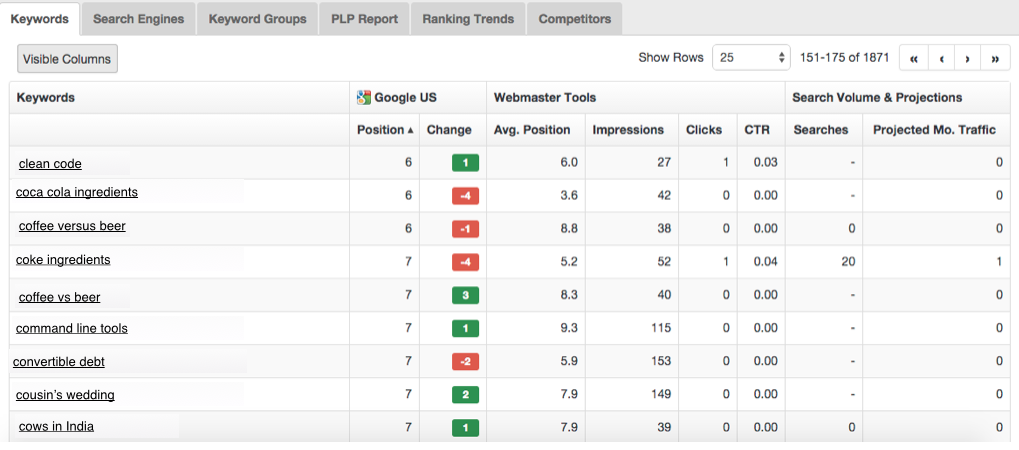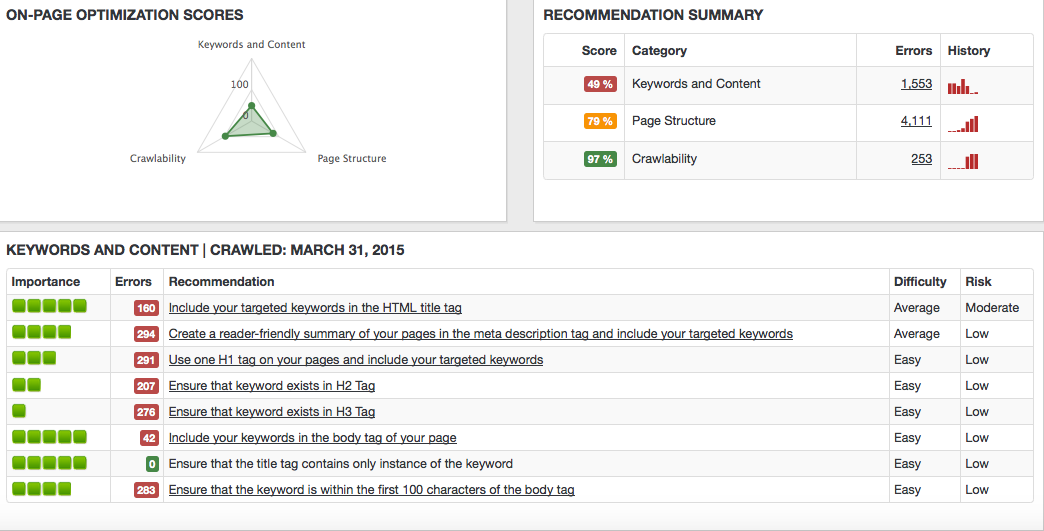Leaving the SEO recommendations and website optimization tasks to the SEO team is great for those marketers who have a responsive SEO team that has the time to optimize every blog post and landing page marketing creates. Unfortunately for a large percentage of marketers, this just isn’t the case. Instead, marketers are finding themselves looking at the backend editor of their blog posts and landing pages and wondering how to improve findability now to help reach marketing and corporate conversion goals.
I know, I know, I hear marketers out there groaning already, burdened by the overwhelming number of things they’re already tasked with and wondering when they’ll have the time to also learn and implement SEO best practices. The good news is, there are five things you can start doing right now while you’re creating your content that will improve your ranking in the SERPs (search engine ranking pages) for your blogs, landing pages, and other marketing generated content.
Content Quality Improves Engagement
So, you probably already heard that creating quality content is the most important thing you can do to improve your SEO value and engagement and you’re probably wondering why anyone would even talk about this. Of course you’re going to create quality content, why would you create anything less? Let me explain what I mean by quality content versus other content. Quality content is content that resonates with your audience and that your audience wants to read. Finding out what content will be most popular with your audience begins with good keyword research. So, quality content isn’t just something that’s well written, as some people may assume. Quality content is targeted to a specific audience around a specific topic and is written to tell a story other people want to hear.

Finding out what people want to hear is as easy and as difficult as finding the actual search terms people are already using when they’re searching on the internet for products and services in your industry. They may also be words or phrases people use on social media or questions they ask on public forums such as Quora.
Having a good SEO tool to help you find and track keywords will make this process easier. Instead of doing all the leg work yourself, an SEO tool can discover keywords from your analytics provider, webmaster tools, search engines, and even from your competitors or other brands who are gaining traffic for topics that are important to your key audiences.
Now that you know what keywords are going to bring audiences and search engines to your site, use them. I don’t mean just stuff them around your landing pages or use them willy nilly in your blogs, that’s black hat SEO and will probably not get you the results you’re looking for.
Build your content around the keywords. Keep in mind that you have a set of keywords or topics that you’re going to provide authentic, original, and valuable content around to inform and entertain your audience. If you write with those topics in mind, you’ll naturally use your targeted keywords. When you proof read your content, look for pronouns and replace them with keywords where it is a natural part of speech.
Search engines love fresh content. Even if you don’t have time to go back and update product and landing pages, publish new blogs to keep your website updated and crawlable by the search engines.
Title Meta Tags Draw In the Search Engines
Before you leave your Word Press site, or other content creation tool, be sure to add in the title meta tags that will help the search engines find your content. Writing the title meta tags is probably one of the most important SEO tasks you can do. If you’re looking to improve the SEO value of any page on your site, try spiffing up your title meta tags and see if you improve your overall SEO.
While SEO practitioners may tell you that writing title meta tags is easy, I think there is a certain art to getting it right. Like anything, it takes practice and you may not get it right the first time. The good news is, it doesn’t hurt to go back and change those if you find you aren’t getting the search engine results you’d hoped for.
The first challenge of writing title meta tags is the length. Keep it under 55 characters or your title will be truncated by the search engines. For most of us marketers, we’ve already had experience expressing ourselves under 140 characters on social media. One way to keep your title tags under 55 characters is to take out articles and connecting words such as “the” “an” “and” “or” etc.. Besides the title length, there are a few things to keep in mind when writing title meta tags:
- Make them relevant
- Put important keywords first
- Make them compelling
Should you include the brand name in the title meta tag? The answer is, it depends. If you feel the brand name will help rank the content in the SERPs and if the brand name is relevant to the content, you can include it. You may want to put it first if the brand is very well known, or leave it to the end for a lesser known brand. If your brand has a very long name, there might not be room for much else, so you need to keep in mind what you’re trying to rank for. Your target keywords might be more important to include than your brand name.
Keywords in the H1 Tag Match Content to Search
The H1 tag is the title of the blog or landing page. Ensure that there is only one H1 tag per page. Other titles and subheadings can use H2, H3, H4 headings. Although there is some controversy around the importance of H1 tags for search engine ranking results, the fact is that these headings are an indicator of overall user experience and will signal to the search engines whether your content deserves to be higher or lower in the SERPs.

Use your target keywords in the H1 tag to lead users into your content. Making sure your H1 tag matches the content of the page and accurately reflects the topic you’ve written about will help reduce the bounce rate on your page and signal the search engines that your content is a good result for those search terms. Your H1 tags are the bread crumbs you leave behind to help users and search engines find the best match to search queries. Provide a clear and accurate path for search engine crawlers and the search engines will reward you with higher positions on the page.
The purpose of H1 tags is to provide a good experience for your users and create a good reputation for your site among the search engine bots. It won’t help your cause to put in information that leads either astray.
Keywords in The Body Copy Show Relevancy
Including keywords in the body copy should happen naturally, if you’re basing your content on keyword research and the body of your page is providing details around your title and header. Anything that your audience is going to read will capture their attention in the first paragraph or two. If your content mirrors your title and header, your keywords will naturally appear up front. Check your content to ensure target keywords appear in the first 100 words and aren’t lost in paragraph three following a long introduction.
Your main content goal is to provide value to your audience and to show the search bots that you deserve to show up in search results. Don’t get carried away with using keywords to simply trick the search engines. It may work for a while, but ultimately you’ll pay the price.
Any content that addresses a topic in reasonable depth will naturally be longer than 200 words. Make sure your body copy is original and engaging enough that your readers will want to share it. Real SEO value comes from content that is linked to other pages on the internet. Earning links means establishing thought leadership and writing content that’s good enough for someone to want to pass it along.
Description Tags Improve Click Through Rates
Don’t leave your backend editor yet, there’s one more thing to do before you hit “publish”. If you’re absolutely on deadline, you can go ahead and publish and come back to the rest of this later. The absence of description tags will not affect your ability to rank, as search engines don’t use description tags. However, they do display descriptions in search listings which help users decide whether or not they want to choose your content over the other results.
Think of your description tags as advertising copy. Make them readable and compelling to attract users. Again, you’ll want to use your important keywords, since they reflect the topics and subjects your content is addressing. Keywords used in your description that match keywords used in the search query will be bolded and make your content appear more relevant than other descriptions without bolded keywords.
One of the most compelling reasons for writing good descriptions of your content is that social networks will either display the first sentence or two of your content or the meta description tag. If the first sentence or two of your post isn’t compelling enough, or if it gets truncated by the 155 word limit, your content may not get the engagement you are looking for. On the other hand, a compelling meta description that’s written for the audience. includes target keywords, and adheres to the 155 word limit may be more compelling and will create better engagement and organic SEO value for your site.
When writing description tags be sure to:
- Keep descriptions under 155 characters.
- Include only alphanumeric characters
- Write them like ad copy – keep them compelling
Start making SEO best practices part of your marketing and content creation best practices and you may find that you don’t have to work as hard creating reasons for audiences to visit your website. They’ll get there organically, using search terms around topics you’ve written about that they’re already interested in.
If you’re need a tool to help with keyword discovery and SEO recommendations, give us a shout and we’ll show you how GinzaMetrics can help.

